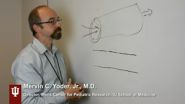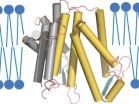(Press-News.org) Spintronics is an emerging field of technology where devices work by manipulating the spin of electrons rather than their charge. The field can bring significant advantages to computer technology, combining higher speeds with lower energy consumption. Spintronic circuits need ways to control electron spin without interference from electron charge. Scientists at EPFL, working with Université Paris-Sud and Paul Scherrer Institut, have discovered that a common insulating material behaves as a perfect spintronic conductor because it is not affected by background electron charge. In addition, the material's properties make it an ideal platform for directly observing a strange subatomic particle that could one day lead to a different, more stable type of quantum computers.
Spintronics
Spintronics (spin-transport or spin-based electronics) is a technology that exploits a quantum property of electrons called spin. Although difficult to describe in everyday terms, electron spin can be loosely compared to the rotation of a planet or a spinning top around its axis. Spin exists in either of two directions: "up" or "down", which can be described respectively as the clockwise or counter-clockwise rotation of the electron around its axis. Ultimately, spin is what gives electrons their magnetic properties, influencing the way they behave when they enter a magnetic field.
The different directions of electron spin can be used to encode information, much like the binary code used in digital communication. Spintronics can therefore open up a new generation of devices that combine conventional microelectronics with spin-dependent effects, overcoming the limitations of today's electronics like speed and energy consumption. The main challenge is being able to actually control electron spin, turning "up" or "down" as needed. This can be achieved with certain materials, but the problem is that these are often susceptible to interference from the charge of electrons.
An ideal material for spintronics
The team of Hugo Dil at EPFL, working with scientists from Paris and the PSI, has shown that a transparent insulating material, which normally does not conduct electrical charge, shows spin-dependent properties. The scientists used a method called SARPES, which has been perfected by Hugo Dil's group. The data showed that the electron gas at the surface of strontium titanate (SrTiO3) is spin-polarized, which means that it could be used to control the spin of electrons.
"This is interesting because it is the first evidence of a large spin polarization effect on a truly insulating substrate", says Hugo Dil. The discovery has significant implications for the future of spintronics, because it can lead to the development of spin-polarized materials that are not susceptible to interference from non spin-polarized electrical charge, allowing for finer and better control of electron spin.
A new particle for a different kind of quantum computer
Beyond spintronics, this insulating material might also be important for quantum computing, as it could be used to directly observe an elusive, strange particle called the Majorana fermion. This particle is unique because it actually is its own antiparticle as well. Sometimes referred to as the "ghost particle", the Majorana fermion has zero energy, zero moment, zero spin, and, so far, has never been observed unambiguously. In the future, Majorana fermions could become the foundation for a different kind of quantum computer that would, in theory, be exceptionally stable, as it would not be susceptible to external interference and noise.
INFORMATION:
This work represents an equal collaboration between Hugo Dil's group at EPFL (ICMP-SOIS), a group from the Université Paris-Sud (CSNSM & CNRS/IN2P3), and experts at Paul Scherrer Institut (Swiss Light Source).
Reference
Santander-Syro AF, Fortuna F, Bareille C, Rödel TC, Landolt G, Plumb NC, Dil JH, Radović M. Giant spin splitting of the two-dimensional electron gas at the surface of SrTiO3. Nature Materials DOI: 10.1038/nmat4107
An innovative laboratory culture system has succeeded, for the first time, in reproducing the full course of events underlying the development of Alzheimer's disease. Using the system they developed, investigators from the Genetics and Aging Research Unit at Massachusetts General Hospital (MGH) now provide the first clear evidence supporting the hypothesis that deposition of beta-amyloid plaques in the brain is the first step in a cascade leading to the devastating neurodegenerative disease. They also identify the essential role in that process of an enzyme, inhibition ...
AMHERST, Mass. – Using a first-of-its-kind, high-resolution numerical model to describe ocean circulation during the last ice age about 21,000 year ago, oceanographer Alan Condron of the University of Massachusetts Amherst has shown that icebergs and meltwater from the North American ice sheet would have regularly reached South Carolina and even southern Florida. The models are supported by the discovery of iceberg scour marks on the sea floor along the entire continental shelf.
Such a view of past meltwater and iceberg movement implies that the mechanisms of abrupt ...
VIDEO:
Researchers have developed a technique to jump-start the body's systems for creating blood vessels, opening the door for potential new treatments for diseases whose impacts include amputation and blindness....
Click here for more information.
INDIANAPOLIS -- Researchers have developed a technique to jump-start the body's systems for creating blood vessels, opening the door for potential new treatments for diseases whose impacts include amputation and blindness.
The ...
DURHAM, N.C. -- Duke University researchers have made fluorescent molecules emit photons of light 1,000 times faster than normal -- setting a speed record and making an important step toward realizing superfast light emitting diodes (LEDs) and quantum cryptography.
This year's Nobel Prize in physics was awarded for the discovery of how to make blue LEDs, allowing everything from more efficient light bulbs to video screens. While the discovery has had an enormous impact on lighting and displays, the slow speed with which LEDs can be turned on and off has limited their ...
From joint replacements to cardiac implants and dialysis machines, medical devices enhance or save lives on a daily basis. However, any device implanted in the body or in contact with flowing blood faces two critical challenges that can threaten the life of the patient the device is meant to help: blood clotting and bacterial infection.
A team of Harvard scientists and engineers may have a solution. They developed a new surface coating for medical devices using materials already approved by the Food and Drug Administration (FDA). The coating repelled blood from more ...
In spite of its dangerous reputation, cholesterol is in fact an essential component of human cells. Manufactured by the cells themselves, it serves to stiffen the cell's membrane, helping to shape the cell and protect it. By mapping the structure of a key enzyme involved in cholesterol production, Rockefeller University researchers and a colleague in Italy have gained new insight into this complex molecular process.
"This is the first report to pinpoint the location of every atom — in this case nearly 3,000 of them — in one of the membrane-embedded enzymes ...
CAMBRIDGE, Mass--A surprising phenomenon has been found in metal nanoparticles: They appear, from the outside, to be liquid droplets, wobbling and readily changing shape, while their interiors retain a perfectly stable crystal configuration.
The research team behind the finding, led by MIT professor Ju Li, says the work could have important implications for the design of components in nanotechnology, such as metal contacts for molecular electronic circuits.
The results, published in the journal Nature Materials, come from a combination of laboratory analysis and computer ...
Two research teams working in the same laboratories at UNSW Australia have found distinct solutions to a critical challenge that has held back the realisation of super powerful quantum computers.
The teams created two types of quantum bits, or "qubits" – the building blocks for quantum computers – that each process quantum data with an accuracy above 99%. The two findings have been published simultaneously today in the journal Nature Nanotechnology.
"For quantum computing to become a reality we need to operate the bits with very low error rates," says Scientia ...
Concerns over human-insecticide exposure has stimulated the development of alternative bed bug control materials, and many essential oil-based pesticides and detergent insecticides have been developed in recent years. But how well do they work? To find out, researchers from Rutgers University evaluated the efficacy of nine essential oil-based products and two detergents that are labeled and marketed for bed bug control. The results are published in an article in the Journal of Economic Entomology.
The non-synthetic bed bug pesticides — which contain ingredients ...
A noninvasive method of delivering a promising therapy for persistent Clostridium difficile (C. difficile) infection appears to be as effective as treatment via colonoscopy or through a nasogastric tube. In their JAMA report, receiving early online release to coincide with a presentation at the Infectious Diseases Society of America's ID Week conference, investigators from Massachusetts General Hospital (MGH) report that oral administration of the therapy called fecal microbiota transplant (FMT) in acid-resistant capsules was as successful as more invasive methods in eliminating ...



